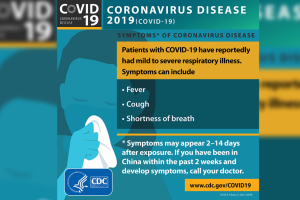Florida Gov. Ron DeSantis disclosed late Sunday that two people in the Tampa Bay area are the first to test “presumptively positive" for COVID-19 and directed his top health official to declare a public health emergency.
RELATED:
- Two people in Tampa Bay area test 'presumptively positive' for Coronavirus
- 2nd person has died from coronavirus in Washington state
- Global economic watchdog warns coronavirus may shrink world economy
Please note: The CDC calls the coronavirus a "rapidly evolving situation" and information is changing and expanding. Click here to access the CDC's latest information.
What is coronavirus?
According to the World Health Organization, coronaviruses (CoV) are a large family of viruses that cause illness ranging from the common cold to more severe diseases. Examples include the Middle East Respiratory Syndrome (MERS-CoV) and Severe Acute Respiratory Syndrome (SARS-CoV). A novel coronavirus (nCoV) is a new strain that has not been previously identified in humans.
The CDC says the 2019 Novel (new) Coronavirus, or COVID-19 is a virus identified as the cause of the respiratory illness outbreak first detected in Wuhan, China. According to the CDC, the virus has now been detected in 60 locations internationally.
"Early on, many of the patients at the epicenter of the outbreak in Wuhan, Hubei Province, China had some link to a large seafood and live animal market, suggesting animal-to-person spread. Later, a growing number of patients reportedly did not have exposure to animal markets, indicating person-to-person spread," the CDC's website says.
"Person-to-person spread was subsequently reported outside Hubei and in countries outside China, including in the United States . Some international destinations now have apparent community spread with the virus that causes COVID-19, meaning some people have been infected who are not sure how or where they became infected."
This website by Johns Hopkins tracks the latest cases of COVID-19 in real-time.
CLICK HERE FORE COMPLETE COVERAGE OF CORONAVIRUS
What are the symptoms?
The CDC says reported illnesses have ranged from mild symptoms to severe illness and death for confirmed coronavirus disease 2019 (COVID-19) cases.
Symptoms include:
- Fever
- Cough
- Shortness of breath
At this time, the CDC believes symptoms could appear as soon as two days after exposure or as long as 14 days.

How is it spread?
The CDC says COVID-19 is thought to spread mainly from person-to-person either between people who are in close contact with one another (about six feet), or through respiratory droplets produced when an infected person coughs or sneezes. According to the CDC's website, the droplets can land in the mouths or noses of people who are nearby or possibly be inhaled into the lungs.
The CDC added that COVID-19 could possibly spread by someone touching a surface or object that has the virus on it and then touching their mouth, nose or possibly their eyes. However, they don't believe this is the main way the virus spreads.
Prevention
The CDC says the best way to prevent illness is to avoid being exposed to COVID-19.
COVID-19 Factsheet by wftsweb on Scribd
They recommend everyday preventative actions to help prevent the spread, including:
- Avoid close contact with people who are sick.
- Avoid touching your eyes, nose, and mouth.
- Stay home when you are sick.
- Cover your cough or sneeze with a tissue, then throw the tissue in the trash.
- Clean and disinfect frequently touched objects and surfaces using a regular household cleaning spray or wipe.
- Follow CDC’s recommendations for using a facemask.
- CDC does not recommend that people who are well wear a facemask to protect themselves from respiratory diseases, including COVID-19.
- Facemasks should be used by people who show symptoms of COVID-19 to help prevent the spread of the disease to others. The use of facemasks is also crucial for health workers and people who are taking care of someone in close settings (at home or in a health care facility).
- Wash your hands often with soap and water for at least 20 seconds, especially after going to the bathroom; before eating; and after blowing your nose, coughing, or sneezing.
- If soap and water are not readily available, use an alcohol-based hand sanitizer with at least 60% alcohol. Always wash hands with soap and water if hands are visibly dirty.
To keep up with the CDC's updates and learn more about COVID-19 click here.



